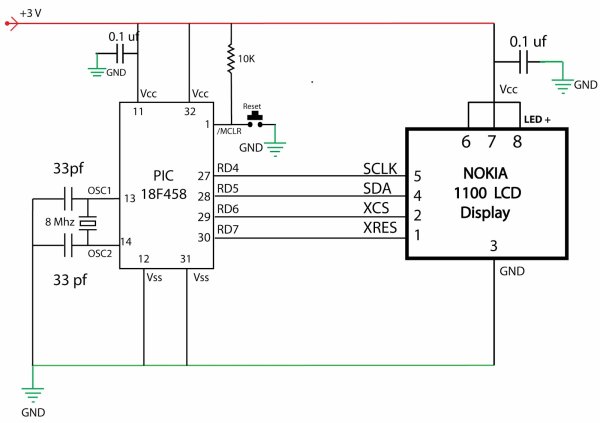Displaying content on a normal alphanumeric display is very limited ,we have to be limited with the font size and we can’t draw any graphics also. but convention Graphics lcd are really very expensive so here is the solution, you can use Nokia 1100 monochrome LCD to display your large font text and graphics . the reason behind using this LCD is ,it is really very cheap and can be powered with 3 volts supply. so it is really good for battery powered application.
Driver IC on this LCD panel is PCF8814 which even though has I2C protocol support – doesn’t use it. Instead it uses simple bit-banging mechanism for communication.

Project Description
however you can use almost any microcontroller (need a little bit extra circuit to work with mcu who doesn’t support 3v) do display content on this LCD, may be that micro controller is PIC , AVR or MSP 430 ,8051 but in this demonstration we will be using Microchip PIC 18F458 Microcontroller.
The software program for this project will be written in C with MPLAB IDE , This LCD has a resolution of 96 x 65 pixels
About LCD:-
Nokia 1100 Graphical LCD uses PCF8814 Controller chip From Philips. It is a chip-on glass(COG) with 9 pin (pin no 9 is not used) connector on the back side of the LCD . You can refer to its datasheet for more information about this controller. (CLICK HERE TO DOWNLOADPCF8814 Controller DATA SHEET).we will discuss only few main points here for out project purpose.
This LCD has 96 x 65 pixels , which mapped directly in the ram memory of the LCD, as shown in the figure blow
The typical example of RAM is shown in the figure blow, The vertical axes area addressed form 0 to 8 with eight bits for each address when combining with x axes, it can be represented as bank.
The horizontal axes are addressed form 0 to 83 and each bit will refer the corresponding pixel in X direction.
Addressing Mode
There are two type of addressing mode in this LCD
Vertical addressing Mode
In vertical addressing Mode each write instruction will increment the address in Y direction and then return to starting address
Horizontal addressing
horizal addressing each wire instruction will increment the address of X direction and return to starting address
For more detail: Nokia 1100 LCD Interfacing with Microcontroller


